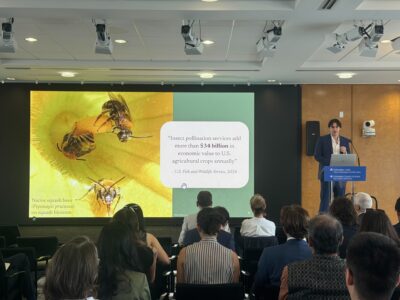
After two years of serving as his native Singapore’s lead climate change negotiator for the United Nations, Desmond Tay enrolled in the 12-month MPA in Environmental Science and Policy (MPA-ESP) program to gain the management skills necessary to solve complex resource and environmental challenges. Desmond plans to combine the knowledge that he has gained from the MPA-ESP program with his interest in climate change mitigation and adaptation to address climate change issues at all levels in the most economically smart, environmentally sound, and socially just manner possible.
1. What drew you to the Master of Public Administration in Environmental Science and Policy program (MPA-ESP)?
I liked that it is a year-long policy-oriented program, as well as the fact that it is co-hosted by two world-renowned institutions (the Earth Institute and School of International and Public Affairs) at an Ivy League university in New York City.
2. What were you doing before you started the program?
I was one of Singapore’s lead climate change negotiators – handling technology and trade-related issues for two years at the United Nations. Prior to that, I was based in Geneva, Switzerland as a trade diplomat for three years representing Singapore at the World Trade Organization.
3. What area of environmental policy and management are you most interested in?
I am interested in climate change mitigation and adaptation. To quote the UN Secretary-General, Ban Ki-moon, “Climate change is the single most important challenge the world faces.” The negative impacts of climate change can be destabilizing for economies and societies. Yet reducing the risks and vulnerabilities to these impacts could entail upfront substantial economic costs and social adjustments. I am interested in policy and management tools that address climate change at the national, regional and international level in an economically smart, environmentally sound, and socially just manner.
4. What is your favorite class in the MPA-ESP program so far, and why?
It is difficult to pinpoint one favorite class. The science classes during the summer semester were excellent because they were taught by very knowledgeable and dedicated scientists and researchers from both Columbia University and the Lamont-Doherty Earth Observatory. For the fall, electives on environmental economics and capital markets are my preferred classes. Going forward into the spring semester, I am excited about the seminar on U.S. foreign economic policy at the Law School. I would say that my favorite takeaway thought is the prospect of weaving different strands of knowledge into effective responses to multi-dimensional public policy challenges.
5. How has collaborating with your fellow students in class projects benefitted you professionally and personally?
The MPA-ESP program brings together high-caliber students of diverse backgrounds and great passion. Citing my workshop group as an example, the 12 group members come from seven countries with different professional experiences. We have in our group a book author-cum-consultant on sustainability, a chief research engineer of a large global electronics company, a staff member of the mayor, government officials, and environmental and nonprofit professionals. By collaborating with my cohort and our faculty advisor, Professor Steve Cohen, we were able to analyze and simulate the implementation the New York Solar Industry and Jobs Act. The workshop provided me with the valuable opportunity to benefit from their perspectives and experiences, and more importantly, build friendships.
6. Beyond the classroom, what, if any, extracurricular sustainability-related activities have you engaged in with your fellow Environmental Science and Policy students?
During the fall semester, the cohort traveled to Langhorne, Pennsylvania to visit the assembly plant at Gamesa, a world-leading wind turbine provider. It is the same plant that President Obama visited just months ago. We gained insights into the plant’s operations, as well as the broader challenges and opportunities of the wind and renewable energy industries. I also recently attended the annual Columbia University Energy Symposium. Organized by students, the Symposium brought together leaders and senior professionals from the private sector, government, non-profit, and academia to exchange views on the complex and dynamic energy sector. Look out for the weekly SIPA newsletter and other newsletters – Columbia and NYC are brimming with countless activities.
7. How do you intend to utilize your degree from the MPA-ESP program to further your career?
I intend to use the knowledge that I have gained from the MPA-ESP program to design and implement good policies. I also plan to and leverage the University, SIPA, Earth Institute, and ESP networks for future collaborations.
Students in the MPA in Environmental Science & Policy program enroll in a year-long, 54-credit program offered at Columbia University’s School of International and Public Affairs, in partnership with The Earth Institute. Throughout this one year program, students are immersed in courses that combine Columbia University’s hands-on approach to teaching public policy and administration with pioneering thinking about the environment. During the summer semester, students learn the fundamentals of environmental science, while the fall and spring semesters focus on teaching the policy and economics necessary to becoming successful environmental analysts and managers. The 62 students come from a wide variety of backgrounds ranging from Sociology to Engineering and come to us from 17 different countries. To learn more about the program, please visit our website.



